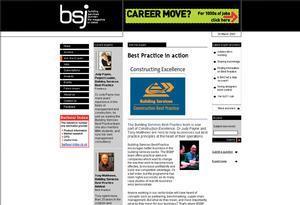One continuously sees references to 'Partnering', 'collaborative working', 'integrated supply teams' etc. Are they different things, or one and the same?
Dr Judy Payne, leader of the ÐÇ¿Õ´«Ã½ Services Best Practice team says that fundamentally, they are the same.
To all intents and purposes, these terms all describe a group of suppliers working in a collaborative manner with the objective of achieving performance improvements on a project by project basis.
Any problems that arise during a project are dealt with co-operatively, on the basis that the client and the contractor have the shared objective of achieving superior project performance over a number of projects.
As a result, all parties deliver lower costs and improved quality without squeezing each other's project margins. Steady profits then provide the basis for investment in improved products and processes, and a virtuous circle of improvement is gradually established for everyone involved.
The number of places offering advice about Best Practice confuses me. Where should I start?
Tony Matthews replies that much 'best practice' information is generic, so it's not surprising that the number of places offering help is high.
ÐÇ¿Õ´«Ã½ Services Best Practice now operates under the umbrella of Constructing Excellence in partnership with five main trade bodies: CIBSE, BSRIA, ECA, FETA and HVCA. It is targeted specifically at the building services supply chain from client, consultant, main contractor right through to specialist contractors, distributors and manufacturers.
And because the volume of information available is so vast, ÐÇ¿Õ´«Ã½ Services Best Practice has created its own website (www.bsbpp.org.uk) or telephone helpline (0845 606 5704) to help with selection of tools from the range available.
We don't condone reinvention of the wheel, but we do produce our own material as well as running our own events, and we will continue to do so.
Vent-Axia: 9 - 22 April
Vent-Axia has provided ventilation solutions since it was founded by Joe Akester in 1936. The company now operates in the commercial, residential and industrial sectors. In more recent times, the company has focused its strategy on providing training for the industry, and on ensuring that better ventilation is also energy efficient and kinder to the environment. Vent-Axia offers training programmes on ventilation compiled from various sources. Courses start at basic level and progress to more technical aspects such as fan and ventilation laws. The company also produces the Ventilation Handbook which covers ventilation rates and requirements, basic units of measurement, design guidelines, condensation control and a system calculator. On environmental issues, Vent-Axia has committed itself to a development programme of manufacturing low energy consumption fans that last longer, use less energy, are cheaper to run and provide occupants with the best possible air quality. Global warming and the drive to reduce CO2 emissions has inspired a new generation of easily installed Vent-Axia low energy products. Other projects include working with the hospitality industry to develop a charter on cleaner air. Vent-Axia is also taking a proactive role in the regulatory committees both in the UK and overseas to drive new regulations. A number of Vent-Axia experts will be online answering your questions on a wide variety of technical aspects such as ventilation design, measurement and installation. They can also offer advice on a range of issues related to energy efficiency, in both the commercial and domestic markets.ÐÇ¿Õ´«Ã½ Research Establishment: 23 April - 6 May
One of the ÐÇ¿Õ´«Ã½ Research Establishment’s (BRE) many roles is to provide advice to manufacturers, design teams and clients on specialist issues such as innovative technologies, complex building forms, and new regulations. BRE help them to create indoor and outdoor environments that are comfortable, productive, safe and, most importantly, that will perform as planned. During its ‘Experts online’ session, BRE will be available to answer any queries you might have about aspects of product testing and development, including the subject of test houses, and the environmental test chamber. Test houses are a facility that housebuilders and manufacturers can use to evaluate their products in a controlled ‘real home’ environment. Using two pairs of near-identical houses with simulated occupancy conditions, BRE can evaluate the thermal performance of a wide range of building products, such as:- heating systems, components and control;
- ventilation and humidity control systems;
- n solar control and cooling systems;
- water-saving and treatment products;
- insulation products;
- building components.
How to contact our experts on www.bsjonline.co.uk
To ask this month’s experts your questions, get onto our website at www.bsjonline.co.uk. You’ll find our Experts Online area highlighted from the home page, so just follow the click throughs. You have to be a registered user to access this great service – but registration is free and quick. Once you’ve found the Experts page, simply type your question into the box at the bottom of the page and ‘send’. You should get your answer in 24 hours – if it’s going to take longer, we’ll let you know. Questions and answers then appear on the website – and you can also search our archive of previous Experts.Source
ÐÇ¿Õ´«Ã½ Sustainable Design

















